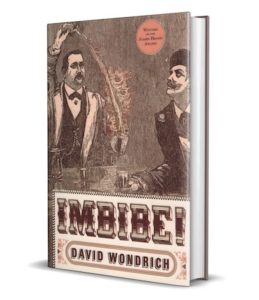Imbibe!, penned by David Wondrich, was released in the United States in November 2007. Initially added to my library shortly after, I promised myself to delve into it soon. However, perhaps the title – IMBIBE! – deterred me, as the figurative meaning of the word escaped me.
I now lean towards the belief that the author’s call was less about imbibing alcohol and more about absorbing new knowledge regarding the evolution of cocktail culture. The book cover sparked my curiosity, featuring Jerry Thomas concocting the Blue Blazer. The etching from the periodical Under the Gaslights finally piqued my interest… exactly one hundred and sixty years after the publication of Thomas’s guide, How to Mix Drinks: The Bon-Vivant’s Companion.

The book unfolds into three parts:
Cocktail Story: Wondrich’s book is effectively three in one. The first part blends Thomas’s biography with social, economic, and gastronomic contexts. It delves into the attention Thomas garnered in America, endorsed by Edward Hingston, a notable bartender in San Francisco, labeling him as “one of the most distinguished, if not the chief, of American bartenders.”
Wondrich tracks his life from November 1, 1830 (or, as he admits, 1829) to December 14, 1885, when the gold digger, sailor, actor, gambler, and above all, bartender, departed to the heavenly bar. This concise overview is more reader-friendly than his life episodes scattered across Anistatia Miller and Jared Brown’s Spirituous Journey. (It’s worth noting that the British duo of historians, the only ones who can compete with the American author in available sources, acknowledge his superiority in the subject and ceremoniously declare, “We won’t bore you with a reiteration of historian Dave Wondrich’s wonderful account of Thomas’s life in his book Imbibe!”)
The subsequent chapter, “How to Mix Drinks, or What Would Jerry Thomas Do?”, offers a breathtaking overview of bar culture’s evolution from the late 18th century to the beginning of Prohibition in the United States. Wondrich defines it as The Archaic Age (1783–1830), The Baroque Age (1830–1885), and finally, The Classic Age (1885–1920). Towards the end, he acknowledges the emergence of “molecular mixology” but deems it beyond the book’s scope. (Though, as it turns out, not entirely true, as revealed a few paragraphs later.)
Each era is outlined along with typical bar tools and their usage. This section, covering about thirty pages, approximately a tenth of the book, ends with a review of spirits and their modern replacements in classic recipes, and a Table of Measurements. It’s surprising to note that a Wineglass holds not 10, but 6 centiliters (2 ounces), and an interesting detail: the jigger, holding 1.5 ounces, only has 1.25 ounces on Wall Street. A saving measure among brokers and bankers, perhaps?
Nearly every page contains fascinating tidbits. For instance: “To be authentic, leave the barspoon in the glass while you strain.” It makes me wonder about the spoon that Kazuo Uyeda introduced to Europe. Its forty or more centimeters could be an eye-opener…
Jerry’s Recipes etc.: Chapters 3 to 7, spanning about two hundred pages or two-thirds of the book, offer a treasure trove. I highly recommend – if possible – studying it alongside any edition of Thomas’s manual. I used a copy dating back to 1928, edited and prefaced by Herbert Asbury. It wasn’t ideal, but one thing was clear from the beginning. David Wondrich comments on selected recipes uniformly. Each title is followed by a historical insight, the recipe itself, ingredient notes, and finally, preparation tips based on the author’s experience. Clear, useful, instructive.
Readers might be surprised that Wondrich’s cocktail list significantly differs from Thomas’s concoctions. Put simply, Wondrich includes titles like Bronx, Jack Rose, Clover Club, and more that Thomas had no inkling about simply because they didn’t exist in 1862. It’s a testament to the evolving cocktail landscape.
It’s undoubtedly useful to acquaint oneself with notorious cocktails like Daiquirí, Aviation, Manhattan, Dry Martini, and relish the wealth of information Wondrich gathered, thanks to his scholarly erudition. After all, a PhD in comparative literature signals his adeptness at drawing from sources – sources that others haven’t dreamt of. However, this approach might confuse readers, leaving them pondering what Imbibe! is truly about. Complicating matters further, the eighth chapter presents signature recipes from contemporary global experts. It’s a noteworthy addition, but its absence wouldn’t have detracted from the book’s essence. Quite the contrary.
Appendices: The book’s conclusion brings another dimension, further refining three critical subjects touched upon in earlier pages.
The first intricately details the production of specialized bar literature since 1779, challenging our long-standing belief that Jerry Thomas’s book was historically the first of its kind, similar to occasional hints that Harry Johnson published his manual two years before in San Francisco.
The second deliberates on the origins of the term ‘cocktail.’ It’s interesting how David Wondrich vehemently supports the theory that the term originally signaled thoroughbred horses to the racing audience.
The third segment reads somewhat like a court transcript, discussing four theories about the Martini’s origin. They’re structured: Statement of Origin. Source of the statement. Arguments For. Arguments Against. Verdict. Needless to say, none of the judgments are definitive. It’s peculiar, especially considering that ten years before Imbibe!, Rutgers University’s classic literature professor, Lowell Edmunds, published an excellent study on the Martini’s origins, resolving the issue credibly, and David Wondrich includes it in his publication’s bibliography. (I reviewed Martini Straight Up in the 2015 issue.)
I let the review settle for a few days before revisiting it. I felt that some critical aspects might deter potential readers. I’d hate that because Wondrich’s book is exceptional. It provides a plethora of often-forgotten information about classic cocktails – who would explain that a julep strainer wasn’t for making a julep but for sipping it through? It dispels myths and reveals valuable craft tricks. In fact, there’s only one problem: Finding its source online, ordering it (costs around 25 euros), reading it, and most importantly, contemplating its content.





